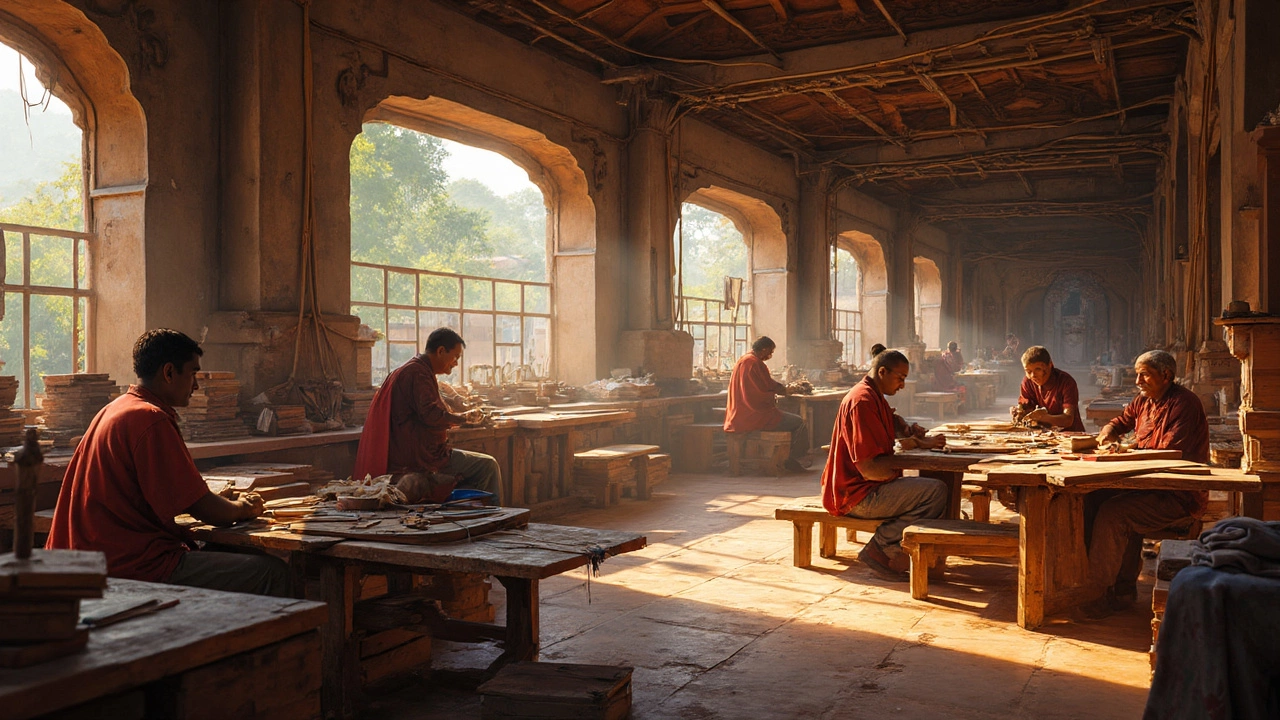Ever wondered where the magic behind your lovely dining table or comfy sofa begins? If you're in the furniture business, you'd know just how crucial picking the right place to manufacture your pieces can be. Let's face it, not all places are created equal when it comes to sourcing the best materials, labor, and tech for making furniture.
Now, India is a pretty hot topic on the furniture-making map. Why? For starters, India has this rich tradition of craftsmanship that has been passed down through generations. It's like they've got furniture-making in their DNA! This means you get a blend of quality and artistry that's hard to beat.
Then there's the cost factor. Manufacturing in India often comes with serious cost advantages. It's not just about the cheaper labor—though that's a big part of it—it's also about a diverse range of local materials like teak, rosewood, and bamboo that are readily available. It's like having the best ingredients always on hand to whip up the perfect dish.
- India: A Craftsmanship Haven
- Cost-Effectiveness and Materials
- Skilled Labor Force
- Technological Advancements
- Comparing Global Alternatives
India: A Craftsmanship Haven
India has been a hub for furniture manufacturing for centuries, and there's a pretty good reason why. The country boasts a rich heritage of craftsmanship that's as colorful as its festivals and culture. This isn't just about putting a table together; it's about infusing art and tradition into every piece.
Take Jaipur, for instance. Known for its intricate carvings and artisanal woodwork, this city is like a giant workshop filled with skilled artisans. These craftsmen bring generations of expertise to the table, literally! This isn't something you can just pick up overnight.
But it's not all traditional. Cities like Bengaluru and Pune are where you'll find a mix of tradition and modern technology. Here, skilled workers are embracing the combo of handcrafted designs with high-tech production methods. This means you can get custom-made pieces with precision that only technology can provide, without losing that unique handmade touch.
Beyond just the craft, India also offers a huge variety of materials. Whether you're looking at exotic woods like teak and rosewood or something unique like mango wood, you'll find it all locally. This abundance of materials keeps costs down and quality up, making India an ideal spot for furniture production.
Cost-Effectiveness and Materials
When it comes to furniture manufacturing, keeping costs low without sacrificing quality is critical. This is where India shines brightly. The country offers a unique mix of low production costs while maintaining high quality, making it a preferred destination for many businesses.
One major attraction is the cost of labor. Compared to Western countries, wages in India are lower, yet the skill level is impressively high. This allows manufacturers to benefit from skilled craftsmanship without breaking the bank, which is a sweet spot that not many locations can offer.
Moreover, India has a treasure trove of natural materials. The availability of diverse woods like teak, rosewood, and mango wood allows for manufacturing a variety of furniture styles. These materials are not only known for their aesthetic appeal but also for their durability and workability, giving manufacturers flexibility in design.
Here's a fun fact: India is one of the world's largest producers of bamboo, and it's increasingly being used in the production of furniture as a sustainable and eco-friendly alternative. This not only helps in reducing carbon footprints but also adds to the variety of materials available for new and innovative designs.
Overall, the cost-effectiveness in India isn't just about cheap labor; it's a harmonious balance of affordability, expertise, and quality resources. This makes it a compelling choice for those looking to enter or expand in the furniture market.

Skilled Labor Force
There's something special about the way furniture is crafted in India. It's like watching an artist at work, only instead of paints and brushes, they're using wood and tools. This isn't surprising when you think about it. India has one of the largest labor markets in the world, brimming with skilled hands ready to turn raw materials into stunning pieces.
One of the coolest things about India is the depth of its talent pool. The country embraces its age-old traditions of carpentry and craftsmanship, and this has led to a workforce that's both highly skilled and innovative. In many regions, especially in places like Jodhpur or Jaipur, families have been passing down these skills through generations. It's like having a family heirloom, but instead of a piece of jewelry, it's knowledge and technique.
Now, don't think for a moment these artisans are just sticking to old methods. They’re super adaptive and are often integrating modern techniques with traditional skills, creating furniture that's not just beautiful but also functional for today’s needs. And this blend of old and new keeps India ahead in the furniture manufacturing game.
Plus, if you're considering quality alongside tradition, India doesn't disappoint. The labor force in the furniture industry here is known for its attention to detail and commitment to excellence. You'd be hard-pressed to find a country with a workforce more devoted to crafting impeccable furniture at competitive pricing.
To give you a sense of the labor costs, here's a small comparison table:
| Country | Avg. Labor Cost (USD/hour) |
|---|---|
| India | 1.5 |
| China | 3.6 |
| Vietnam | 2.5 |
You can see why choosing India might just tick all the boxes—affordable and quality craftsmanship. With a focus on sustainability and creativity, the skilled labor force keeps India at the top of furniture manufacturing destinations.
Technological Advancements
Now, let's talk tech in the realm of furniture manufacturing. India isn't just about traditional woodworking skills; it's also stepping into the modern age with tech advancements that are shaking up the industry. Imagine mixing ancient craftsmanship with next-gen technologies—that's India for you!
One major player in this transformation is the use of Computer Numerical Control (CNC) machines. These bad boys allow for precision cutting and efficient mass production without losing the quality that handcrafting provides. So, you're getting that fine Indian artistry with a touch of robotic precision.
3D printing is another innovation that's slowly gaining traction. While it might still be in the early stages for furniture, it's opening up rebellious new designs that were once thought impossible. Designers can experiment with intricate patterns and shapes that would be crazy complex with traditional methods.
India isn't slacking when it comes to eco-friendly solutions either. Many manufacturers are hopping on the sustainability trend. They're investing in tech that reduces waste and energy use, like adopting solar energy systems in factories. Plus, with the increasing global demand for eco-conscious products, this green tech is perfect for attracting the modern, mindful customer.
We can't forget about the digital management systems that are optimizing everything from supply chains to customer orders. These systems help manufacturers keep track of orders more efficiently, reduce delivery times, and basically make the whole operation smoother.
Let's take a quick glance at how tech adoption varies across sectors:
| Sector | Technology | Adoption Level |
|---|---|---|
| Wood Processing | CNC Machines | High |
| Design | 3D Printing | Medium |
| Energy | Solar Systems | Growing |
| Supply Chain | Digital Management | High |
All in all, India is really embracing tech to not just keep up with global demands but to lead the charge in sustainable and efficient furniture production.

Comparing Global Alternatives
Alright, so let's say India doesn't quite fit the bill for your furniture manufacturing needs. Where else might you look? Several places around the globe bring their own unique flavor to the table.
Let's start with China. It's the big kid on the block in the furniture world, known for massive production capabilities. The pros are clear: economies of scale, a vast network of suppliers, and advanced manufacturing technologies. However, keep in mind that this comes with its own share of challenges, like potential quality control issues and the ever-changing trade regulations with other countries.
Then you’ve got Vietnam, which has been on the rise as a furniture manufacturing hub. It offers some of the lowest production costs while maintaining decent quality. Labor costs are lower than China, making it an attractive alternative, especially for large-scale production runs.
Eastern Europe, with countries like Poland, is another alternative worth noting. They might not be as cost-effective, but they're winning points for craftsmanship and access to the European market. If high quality and shorter shipping times to Europe matter for you, then this could be a contender.
Mexico is also joining the mix, particularly for those targeting the North and South American markets. It's geographically strategic for import/export and offers some cost advantages, although not as low as Asia.
Let's compare some key factors:
| Country | Labor Cost | Production Capacity | Quality Control | Market Access |
|---|---|---|---|---|
| China | Medium | High | Variable | Global |
| India | Low | Medium | High | Global |
| Vietnam | Low | Medium | Moderate | Asia, US |
| Poland | High | Low | High | Europe |
| Mexico | Medium | Medium | Good | Americas |
When deciding on the best place to manufacture furniture, think about your priorities. Is it cost, quality, market access, or something else entirely? The choice might change depending on the unique needs of your business.
